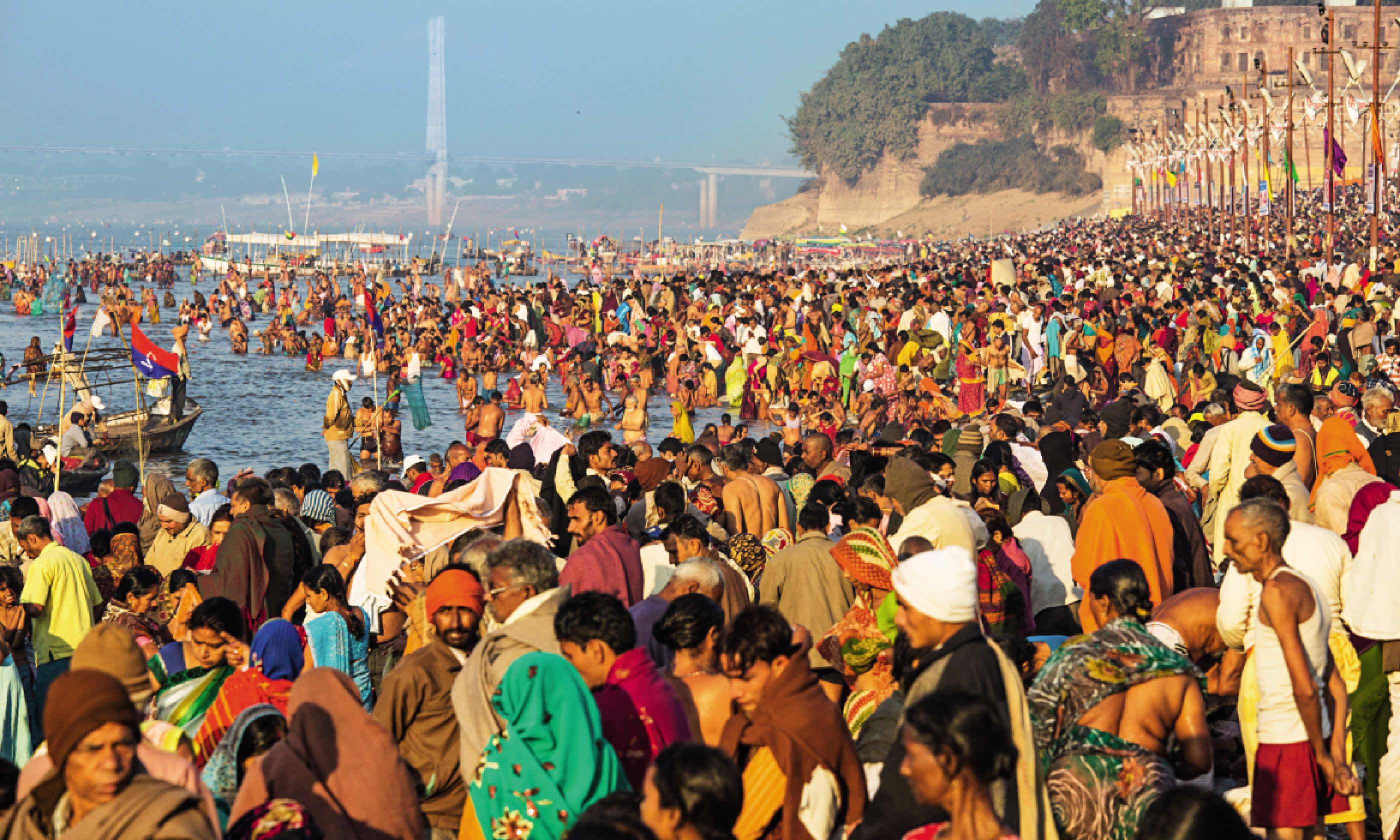
India's Kumbh Mela: the greatest show on earth
Fancy joining a party of 100 million people? India’s Kumbh Mela is a festival like no other – a mass of ritual bathing, naked sadhus, flashing lights and spiritual cleansing. We enter the fray...
“Hare Krishna, Hare Krishna, Krishna Krishna, Hare Hare...” All night long. Over and over and over again. They were driving me crazy. When I rose at 5am, the chant had burrowed so deep into my subconscious I was considering shaving my head and taking up the tambourine. Instead, I unzipped my tent, yawned and gazed onto the Ganges. I couldn’t make out the opposite bank of India’s most sacred river because its silvery flow coalesced with a bleached sky to form one milky full-framed horizon. A phalanx of cormorants skimmed by; a black kite lurched overhead, swooping and rising. Then I heard it.
Despite being 5km upriver from the city of Allahabad, location of the 2013 Kumbh Mela, I could hear it. Now, the Hare Krishnas had been subsumed into a distant cacophony of devotional singing, arriving trains, gridlocked buses, beating tabla drums and the flute-trill of a thousand snake charmers. All underpinned by the murmur of a million people.
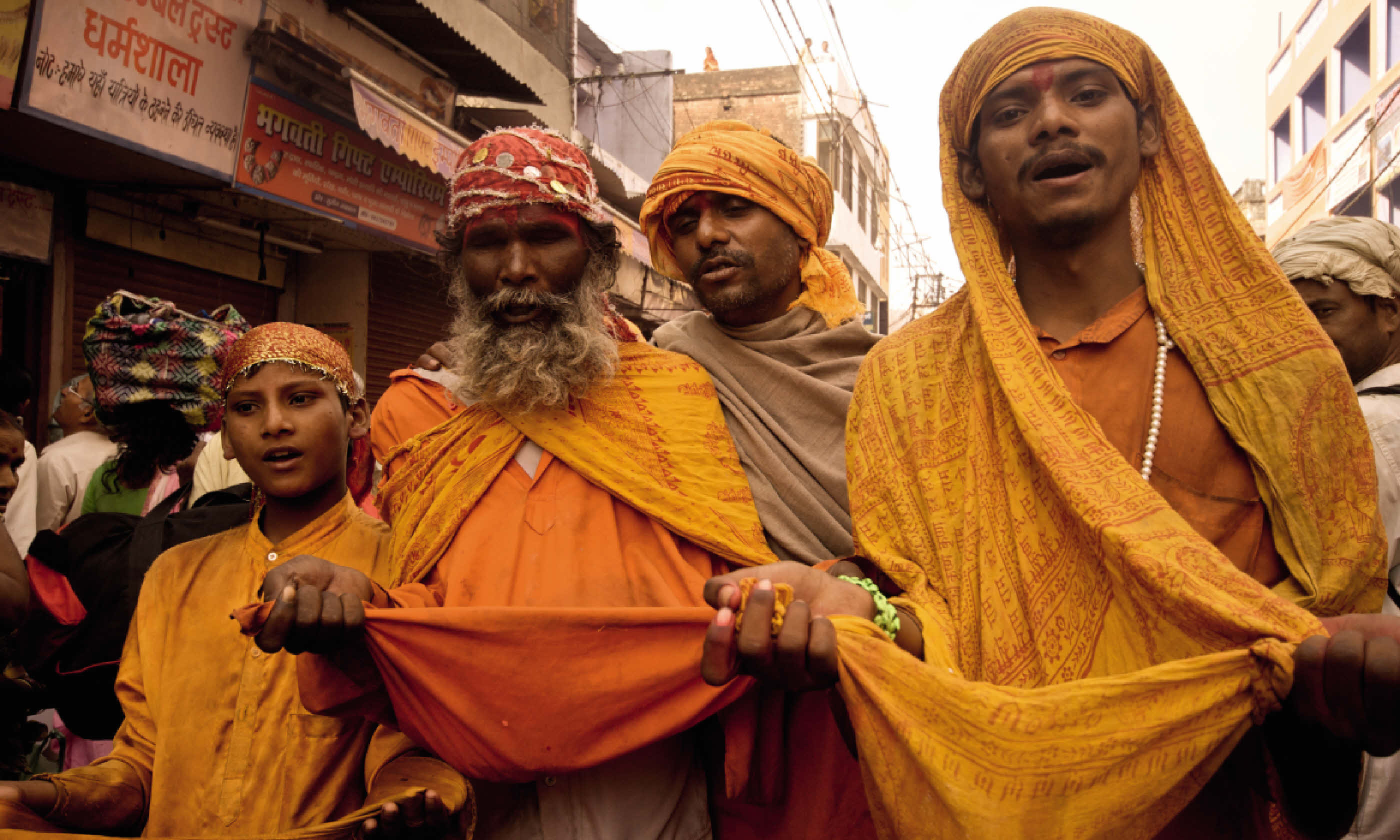 Receiving alms (Mark Stratton)
Receiving alms (Mark Stratton)
“We’re walking to Allahabad,” said Rajiv, a Delhi pilgrim from the tent next door. “Come and join us.” I downed a milky sweet chai from the mess tent and we set off along the Ganges. Allahabad is so congested by pilgrims that I was lodged upriver in a temporary camp. Walking was the only way in.
Sacred cities
Kumbh Mela attracts vast crowds of Hindus from across India. I’d visited the previous Kumbh Mela in Haridwar in 2010 and been swept along by a single day’s crowd of 11 million pilgrims.
Occurring four times during an astrologically determined 12-year cycle, each two-month long
mela (‘gathering’) commemorates an ancient Hindu story. Thousands of years ago a sacred elixir of immortality (
amrita) spilled from a pitcher (
kumbh) during a celestial struggle between demons and gods. The elixir fell on four sacred river cities that now alternately host the Kumbh Mela: Allahabad (Prayag), Haridwar, Ujjain and Nasik. It’s at these sanctified locations that pilgrims come to perform bathing rituals, believing they will wash away sins and hasten the breaking free from
samsara (the cycle of reincarnation) to achieve
moksha – final unification with the universal God, Brahman. Acquiring knowledge and karma, giving alms and practising meditation further this spiritual quest.
Crowd control
After an hour hiking alongside the Ganges, what loomed ahead was a sight that could’ve been either a music festival 50 times larger than Glastonbury or an immense refugee humanitarian crisis. Stretching tens of kilometres across an exposed floodplain east of Allahabad was a temporary canvas-and-tarpaulin city. Its skyline was pierced by great tented ashrams with towering fake facades built to resemble Mughal forts and Taj Mahals.
Around these camps, swollen crowds marched, waving giant flags and tridents (the symbol of Shiva). I became embedded amid a thousand-or-so orange-robed pilgrims chanting and singing, and passed a dreadlocked sadhu with both legs tucked behind his neck. An elephant daubed in swastikas manoeuvred deftly through us all.
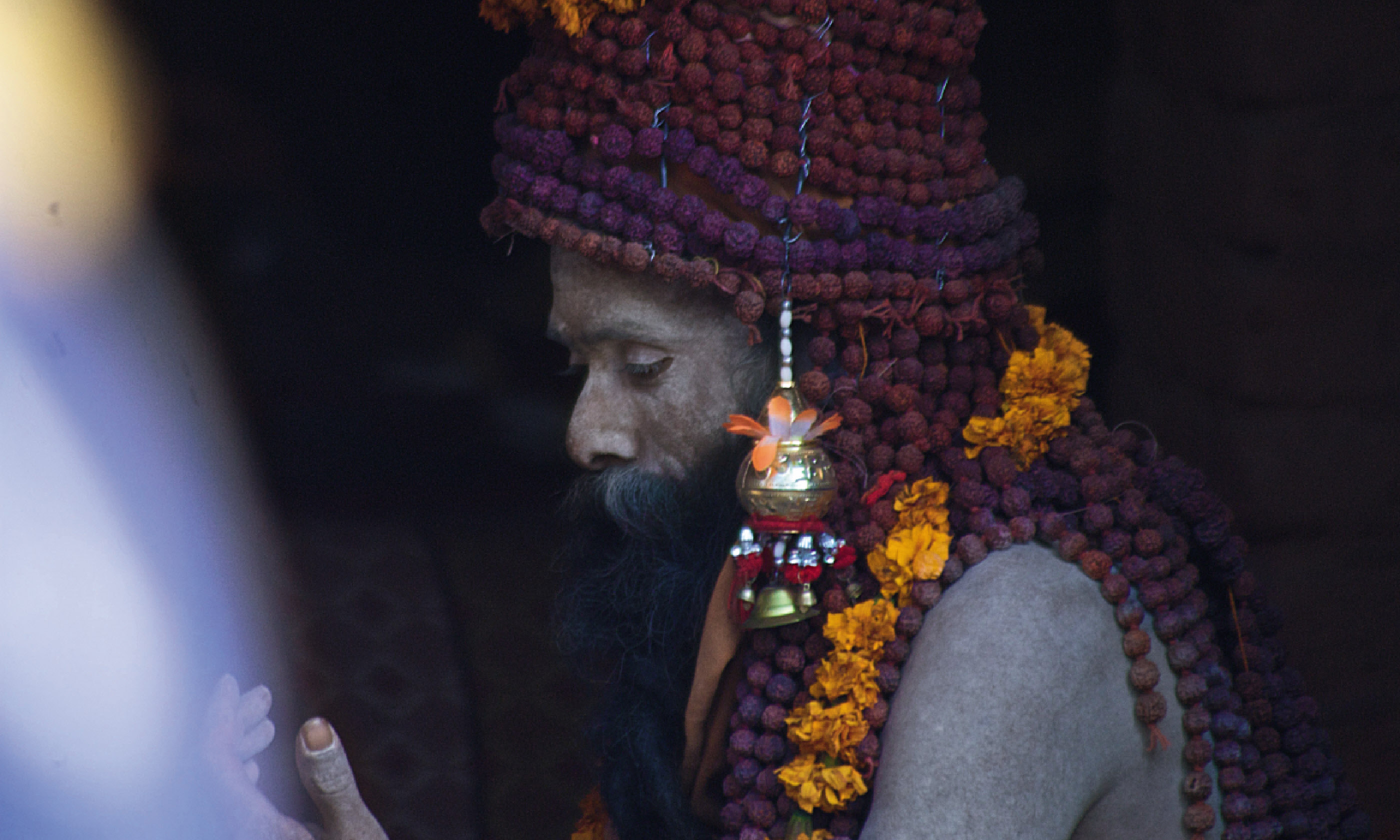 Kumbh Mela sadhu (Mark Stratton)
Kumbh Mela sadhu (Mark Stratton)
Braiding rivers of buffeting pilgrims were flowing in one direction: towards the mela’s epicentre at the sacred Sangam. Here, the Ganges, sluggish in low season, meets the River Yamuna, which arrives from Delhi. It’s at this confluence that the amrita fell. Local legend even claims a third unseen river flows beneath both – the Saraswati, which manifests as a goddess of knowledge. Everybody wants to bathe here.
It was only 8am yet tens of thousands besieged the Sangam’s exposed sandy riverbank; many had made long pilgrimages across India to be here. Mark Twain experienced this energy when he visited the 1894 mela. ‘It is wonderful,’ he wrote, ‘the power of a faith like that, that can make multitudes upon multitudes of the old and weak and the young and frail enter without hesitation or complaint upon such incredible journeys.’
Most pilgrims were in a state of undress. Men were stripped down to their underpants, while women entered the Ganges in full saris, which they later dried by holding them to the wind like kites. Some devotees meditated cross-legged, oblivious to the surrounding brouhaha. Others recited invocations, scooping up Ganges water in brass puja pots before allowing it to cascade downwards. Youngsters frolicked as if enjoying a beach holiday. The noise deafened: yelling and laughter; ululating women; vendors touting candyfloss; whistling policemen vainly attempting to enforce some crowd control.
I saw familiar faces from my last mela including Saroj, a sadhu who balances a calabash of sacred water on his head for 18 hours a day. He’d changed. Last time he bore a vase of flowers. He was symptomatic of everybody seemingly doing his or her own thing, the meaning of which can seem baffling to non-Hindus. I met Dr Charak, a Delhi physician, who explained that pilgrims might follow any multitude of rituals and prayers prescribed by teachers and scripture. The merit from these rituals intensifies during the Kumbh Mela’s auspicious timing, he explained: “I’m not a particularly religious man, but I trust the ancient sages’ wisdom about the relevance of astronomical factors at auspicious events like the Kumbh.”
I didn’t fancy putting this concept of unquestioning belief to the test. The Ganges looked grimly stagnant, awash with floating debris such as sopping marigold garlands and frivolously discarded undies. Yet those returning from their dip radiated energised smiles. I asked the sopping doctor how he felt after his.
“I feel the immense faith and sacred thoughts of millions generating powerful benevolent vibrations, so you come out of the water feeling spiritually, mentally and physically rejuvenated,” he replied.
Going with the goddess
I traipsed onwards across the sandy floodplain towards the Yamuna’s northern bank, slaloming through a tide of buoyant bathers who were flowing towards the Sangam. My progress was slow; I stopped repeatedly to pose for photographs – in this industrialised city, which rarely features on holiday itineraries, foreigners are a novelty. That said, Allahabad has one very noticeable attraction: an impressively chunky fort overlooking the Yamuna, built by Mughal Emperor Akbar in 1583. A breakaway tributary of pilgrims poured through a gateway in the fort’s eastern wall and swept me into its 2,000-year-old underground Patalpuri temple. In this dark catacomb, I shuffled millipede-like past icons of elephant-headed Ganesh and wrathful multi-armed Kali.
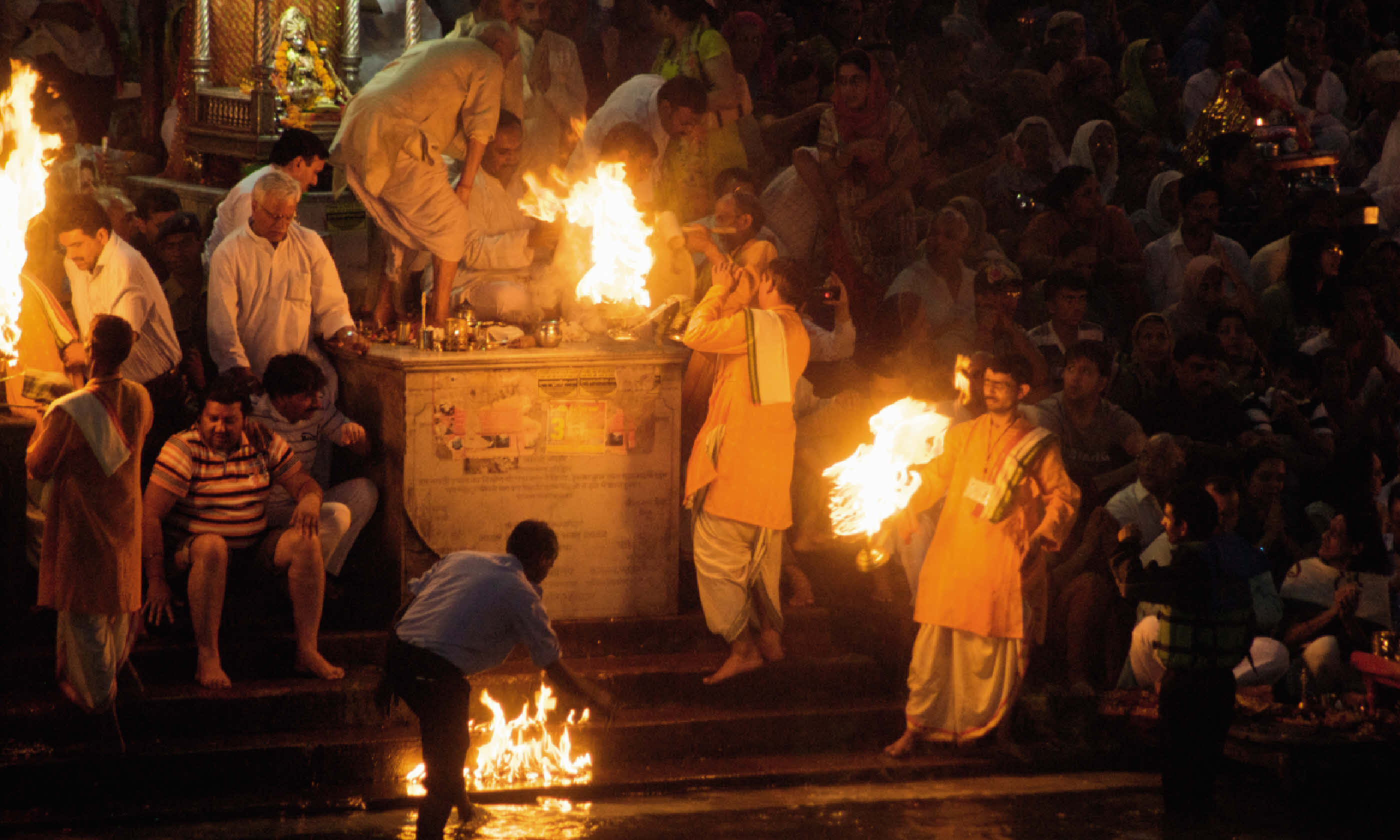 Arati ceremony at the Har ki Pauri ghat (Mark Stratton)
Arati ceremony at the Har ki Pauri ghat (Mark Stratton)
The temple passageway exited near a well of murky sludge. “It’s the Saraswati River, the only place you can see it,” enthused one pilgrim. “Do you feel Goddess Saraswati’s energy?”
“Oh yes,” I lied. The toxic gloop below looked like a fast track to the next life.
Beyond the fort I took brief respite in the corporeal world, sipping gingery masala chai served in terracotta teacups and snacking on fried pakora triangles while watching a man who’d decorated his cow in sequinned cloth make a killing from baksheesh. A wailing drone nearby turned out to be a Wall of Death circus act. Motorcyclists careered centrifugally around a wooden velodrome that vibrated so much it looked like it might buckle at any minute.
Searching for sadhus
I ventured back onto the floodplain to seek Kumbh Mela’s most brazenly photogenic spectacle, the akhara camps. Sadhus are India’s most recognisable holy men: wandering ascetics who’ve renounced materialism and family to dedicate themselves to attaining moksha. Characterised by saffron and orange clothing, long beards and dreadlocks, several hundred thousand of them attend the mela. Akhara refers to loose groupings of them brought together by shared doctrine and deities.
A furious horn-blaring jam of auto-rickshaws and Ambassador taxis announced the akhara camps. Hundreds of pesky Hare Krishnas were holding up traffic, chanting and dinging cymbals in front of a portable shrine pulled by the two biggest oxen I’ve ever seen.
I asked a policeman if he knew the whereabouts of Juna akhara camp. He pointed the way, adding: “They like to keep hidden to preserve their decency but be careful because they can be fierce.”
He was referring to Juna akhara’s pre-eminent
naga babas (naked sadhus). I had been captivated by their ferocity at the 2010 mela, when I watched thousands of these naked followers of Shiva parading, waving swords and tridents, as their leaders rode chariots.
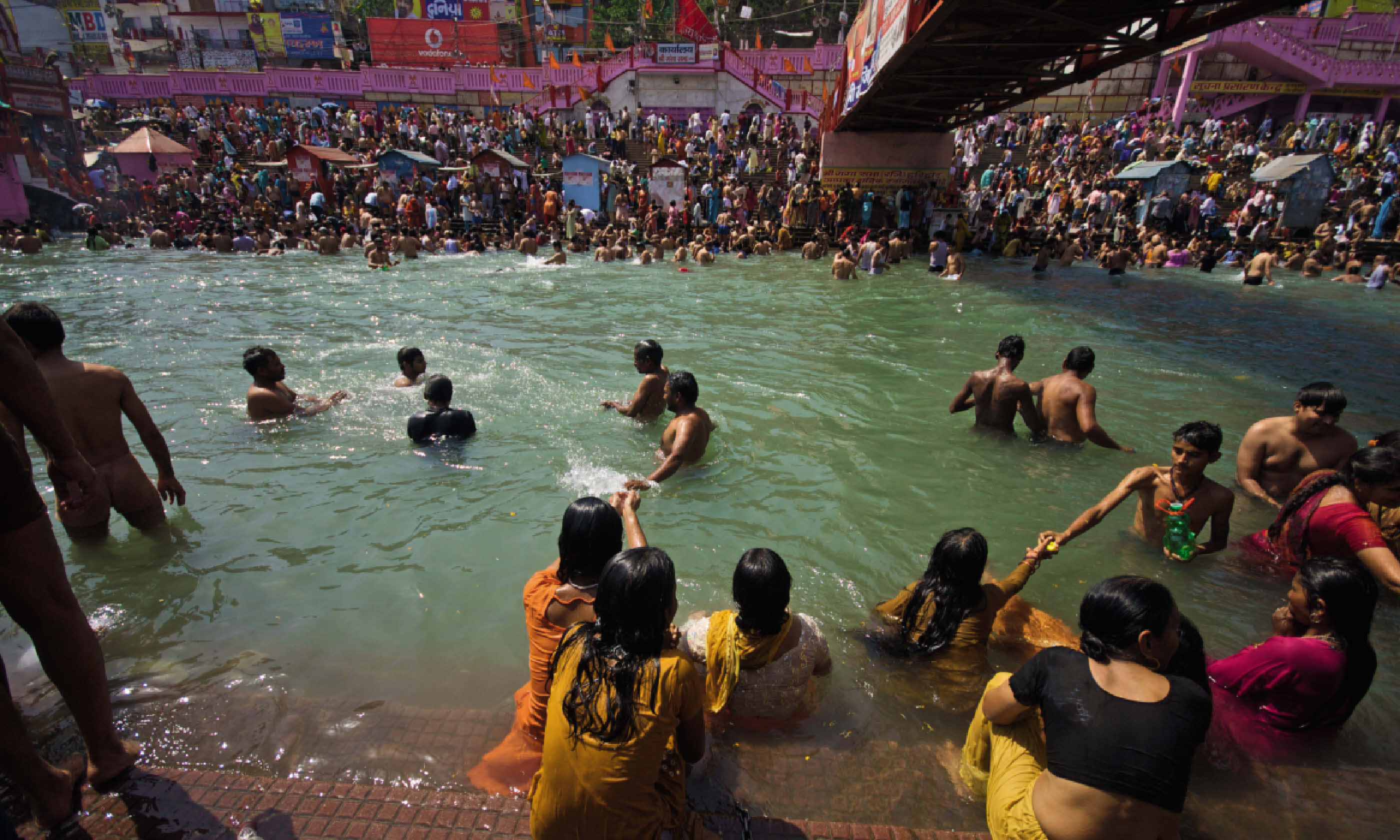 Har ki Pauri ghat (Mark Stratton)
Har ki Pauri ghat (Mark Stratton)
A fug of marijuana smoke hung over Juna akhara, announcing these enigmatic ascetics’ predilection for THC-assisted ‘clarity’. Taking renunciation to the extreme, they sit naked in lotus position smeared in ash, mimicking Shiva for whom ash symbolised death and regeneration. I watched Indian visitors queue for blessings equally agog at the sadhus’ ghostly pallor, wild matted hair, tousled beards and faraway eyes. Some burned logs to keep warm; others conversed on unrenounced mobile phones.
It’s challenging to talk to them – and not just because they are stark naked, often with their penises looped around their waists like belts. The wisdom they dispense is cryptic; perhaps scrambled by repeated drags on marijuana-infused chillums. However, what some endure to express devotion defies belief.
I met one sadhu with a withered arm, atrophied because he’d kept it raised above his head for a decade; his uncut fingernails corkscrewed like springs. Another sadhu dozed upright, draped over a suspended swing to support his ulcerated legs – he’d chosen not to sit down for eight years. Jhoola Baba had 21,000 needle piercings. The sadhus with 10m-long hair and 50-year-old beards were tame by comparison. Later I saw drunken Aghori, ascetics who shatter all of society’s taboos, from alcohol abuse to cannibalism of the dead at cremation grounds.
Something for the soul
Mooching around the camps (visitors are free to come and go), I bumped into Ravinder Singh, a Californian Sikh. He’d come to meet his spiritual guru, Baba Jagtarmuni-Ji, who – he alleged – performs miracles. “I’ve come back after 25 years to refresh my eternal spirit. Jagtarmuni’s wisdom will guide me,” Ravinder said. I was about to leave him to it when he added, “There’s no point coming here to walk around taking pictures. You must get something from Kumbh Mela for your soul.” Feeling shallow, I agreed to meet his Baba.
Jagtarmuni meditated beneath a spacious awning. We drank chai and ate sugary
ghee sweets. His intensely watchful eyes, shaded under the precipice of a huge red turban, bore into me as we exchanged pleasantries. He wanted to know what I was seeking (dare I say great photographs?) before launching into a CV of his psychic abilities. “I was dying in a Mumbai hospital once, but left my body and existed in another for three years until my original healed.” “He has the ability to levitate, he flew across the Ganges once,” interjected Ravinder.
It was all getting a bit weird. Then the grinning Baba pulled out a pot of black paste. “This will help you see clearer,” explained Ravinder. I bade farewell and left.
Mystic magic
Sunset. The camps had gone all Las Vegas. Ashram facades flickered into psychedelic lightshows of spinning hypnotic disks and rotating swastikas. I began my hour-long walk back to camp alongside the moonlit Ganges, glad to sink into darkening anonymity after the day’s sensory overdose. Trails of pilgrims trudged equally wearily, making their ways back to their camps. Some simply bedded down alongside the river.
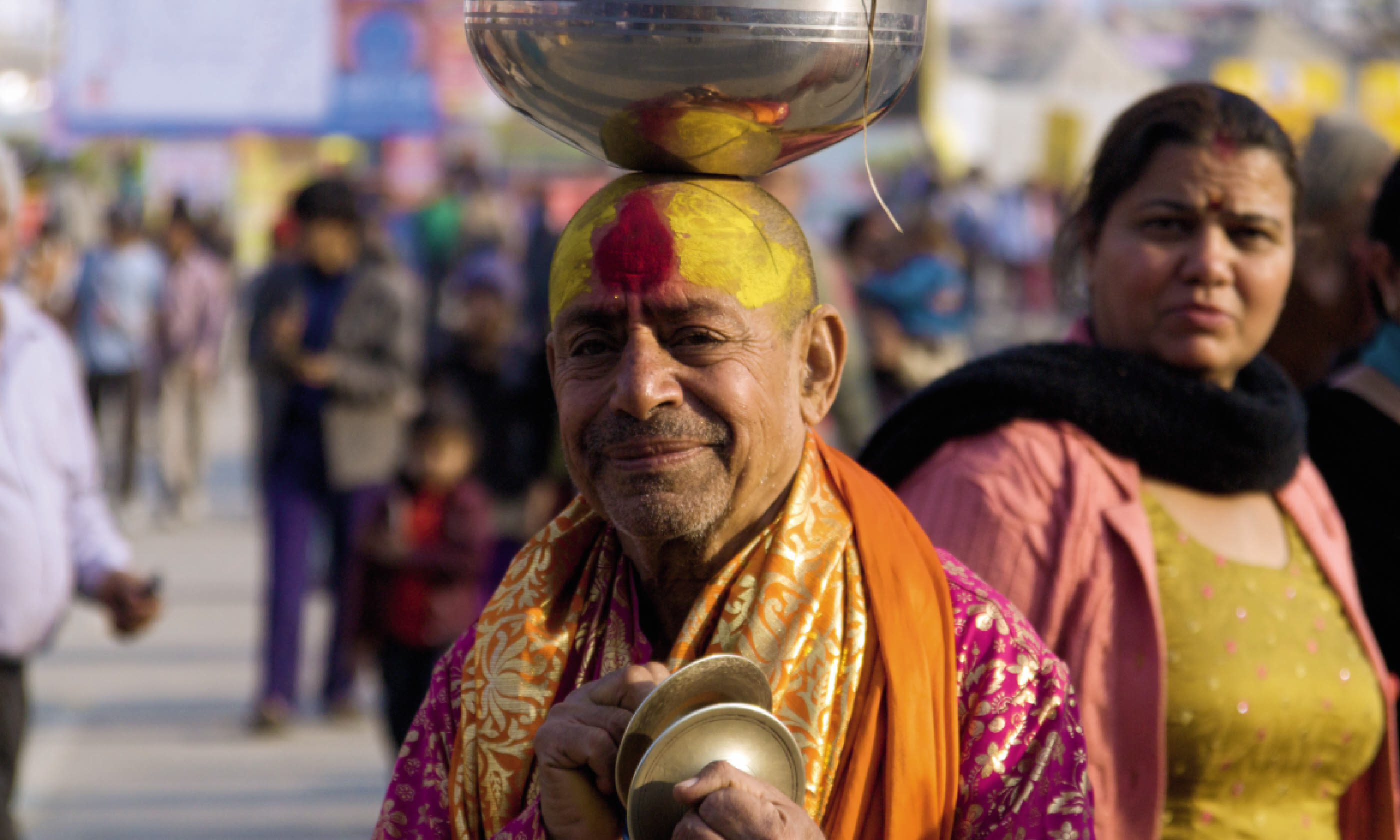
For travellers to India, Kumbh Mela is the ultimate expression of an absorbing religion that makes this country such a vibrantly mystical experience. Mark Twain coined this appeal beautifully in
Following the Equator: ‘In religion, all other countries are paupers. India is the only millionaire.’
Halfway back to camp an armada of tealights in folded leaf-boats drifted with the torpid Ganges flow. An arati, or invocation to the sacred river, was being performed. I sidled up alongside pink-robed devotees swaddled against the cold to watch their guru rotating a lit lantern; his single voice chanted a wistful refrain: “Hari Ganga”. It was a rare moment of low-key reflection since my early morning’s rude awakening. I vowed to return to the next mela in Nasik in 2015. To return to the greatest show on earth.
Make it happen
Booking accommodation and trains during Kumbh Mela can be a huge challenge.
Transindus, which tailor-makes mela packages, can make the process much easier.
Getting to the Kumbh Mela from India’s international gateways is a logistical challenge. The author travelled to Allahabad by train, but for travel at this time
Indian Railways tickets must be booked months in advance; achieving this online is akin to banging your head against a brick wall. Seriously consider getting a tour operator. Nasik is four hours north of Mumbai by rail. Buses from Mumbai to Nasik take five to six hours and cost very little; book in advance with
RedBus.
It may be possible to book hotels in Nasik as late as six months in advance of Kumbh Mela. Establishments will have upped their prices, and will most likely be offering all-inclusive rates. Another solution – and better for atmosphere – is to stay at one of thousands of camps.
Thar Camps ran the author’s camp at Allahabad 2013, with comfortable well-appointed en-suite tents and all-inclusive meals.
Kautilya Society hosted a camp at Allahabad; contact them for information about Nasik 2015.
All images: Mark Stratton





